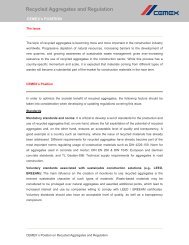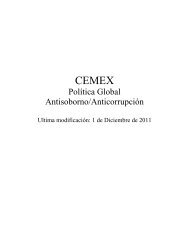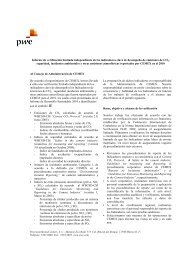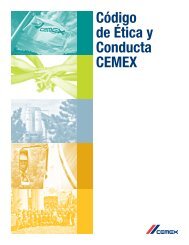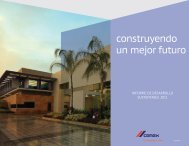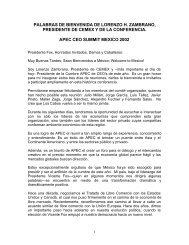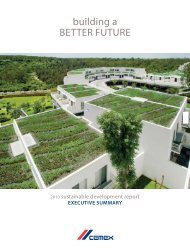building a STRONGER foundation - Cemex
building a STRONGER foundation - Cemex
building a STRONGER foundation - Cemex
You also want an ePaper? Increase the reach of your titles
YUMPU automatically turns print PDFs into web optimized ePapers that Google loves.
Our operations are subject to environmental laws and regulations.<br />
Our operations are subject to a broad range of environmental laws and regulations in each of the jurisdictions in which we<br />
operate. The enactment of stricter laws and regulations, or stricter interpretation of existing laws or regulations, may impose new risks<br />
or costs on us or result in the need for additional investments in pollution control equipment, which could result in a material decline<br />
in our profitability.<br />
In late 2010, the U.S. Environmental Protection Agency (the “EPA”) issued the final portland cement national emission standard<br />
for hazardous air pollutants under the federal Clean Air Act (“Portland Cement NESHAP”). This rule requires Portland cement<br />
facilities to limit emissions of mercury, total hydrocarbons, hydrochloric acid and particulate matter, and is scheduled to take effect in<br />
2013. The EPA also promulgated New Source Performance Standards (“NSPS”) for cement plants at the same time. The Company,<br />
along with others in its industry, has challenged these rules in administrative and judicial proceedings. It is too soon to predict the<br />
outcome of these challenges, although the EPA recently agreed to reconsider certain aspects of the rules. It did not, however, delay<br />
implementation of the rules, and it refused to reconsider certain aspects of the rules considered important to us. If the rules take effect<br />
as proposed, they could have a material impact on our business or results of operations.<br />
In addition, the Company and others in its industry have challenged the EPA’s final emissions standards for commercial and<br />
industrial solid waste incinerators (“CISWI”), which were published in March 2011. The challenges assert, among other things, that<br />
the rules impermissibly overlap with the Portland Cement NESHAP and create ambiguity with respect to how portland cement kilns<br />
will be regulated in the future. If the rules take effect as proposed, they could have a material impact on our business or results of<br />
operations. In May 2011, the EPA announced that it will postpone implementation of the standards while it reconsiders portions of the<br />
rules and addresses related legal challenges. We cannot predict when the EPA will take action to implement the rules, nor whether the<br />
rules will be modified as a result of the pending administrative and judicial proceedings.<br />
The EPA also has proposed regulating Coal Combustion Products (“CCPs”) generated by electric utilities and independent<br />
power producers as a hazardous or special waste under the Resource Conservation And Recovery Act (“RCRA”). We use CCPs as a<br />
raw material in the cement manufacturing process, as well as a supplemental cementitious material, in some of our ready-mix concrete<br />
products. It is too early to predict how the EPA will ultimately regulate CCPs, but if CCPs are regulated as a hazardous or special<br />
waste in the future, it may result in changes to the mix of our products away from ones that use CCPs as a raw material. Based on<br />
current information, we believe, although there can be no assurance, that such matters will not have a material impact on us.<br />
Efforts to address climate change through domestic federal, state and regional laws and regulations, as well as through<br />
international agreements and the laws and regulations of other countries, to reduce the emissions of greenhouse gases (“GHGs”) can<br />
create risks and uncertainties for our business. This is because the cement manufacturing process requires the combustion of large<br />
amounts of fuel and creates carbon dioxide (“CO2”) as a by product of the calcination process. Such risks could include costs to<br />
purchase allowances or credits to meet GHG emission caps, costs required to provide equipment to reduce emissions to comply with<br />
GHG limits or required technological standards, or decreased profits or losses arising from decreased demand for our goods or higher<br />
production costs resulting directly or indirectly from the imposition of legislative or regulatory controls.<br />
The EPA has promulgated a series of regulations pertaining to emissions of GHGs from industrial sources. The EPA issued a<br />
Mandatory Reporting of GHG Rule, effective December 29, 2009, which requires certain covered sectors, including cement<br />
manufacturing, with GHG emissions above an established threshold to inventory and report their GHG emissions annually on a<br />
facility-by-facility basis. We are in the process of complying with this regulation, and do not expect a material economic impact on us.<br />
In 2010, EPA issued a final rule that establishes GHG thresholds for the New Source Review Prevention of Significant<br />
Deterioration (“PSD”) and Title V Operating Permit programs. The rule “tailors” the requirements of these CAA permitting programs<br />
to limit which facilities will be required to obtain PSD and Title V permits for GHG. Cement production facilities are included within<br />
the categories of facilities required to obtain permits, provided that their GHG emissions exceed the thresholds in the tailoring rule.<br />
The PSD program requires new major sources of regulated pollutants and major modifications at existing major sources to secure preconstruction<br />
permits, which establish, among other things, limits on pollutants based on Best Available Control Technology<br />
(“BACT”). According to the EPA’s rules, stationary sources, such as cement manufacturing, which are already regulated under the<br />
PSD program for non-GHG pollutants, would need to apply for a PSD permit as of January 2, 2011, for any GHG emissions increases<br />
above 75,000 tons/year of carbon dioxide equivalent (“CO2e”). Therefore, new cement plants and existing plants undergoing<br />
modification which are major sources for non-GHG pollutants regulated under the Clean Air Act would need to acquire a PSD permit<br />
for construction or modification activities that increase CO2e by 75,000 or more tons/year, and would have to determine and install<br />
BACT controls for those emissions. Beginning in July 2011, any new source that emits 100,000 tons/year of CO2e or any existing<br />
source that emits 100,000 tons/year of CO2e and undergoes modifications that would emit 75,000 tons/year of CO2e, must comply with<br />
PSD obligations. PSD permits can involve significant costs and delay.<br />
In addition, environmental groups have challenged the recently issued NSPS for the cement sector claiming that EPA violated<br />
the Clean Air Act by failing to include limits for GHG emission. The costs of future GHG-related regulation of our facilities through<br />
these efforts or others could have a material economic impact on our U.S. operations and the U.S. cement manufacturing industry.<br />
14



